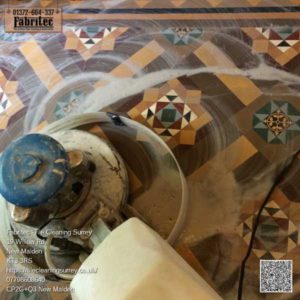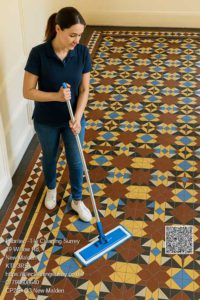Enhance Your Living Space with the Elegant Restoration of Victorian Tiles
Victorian hallway tiles are not only a stunning addition to your home, exuding historic charm and grace, but they also demand careful cleaning and maintenance to retain their exquisite beauty. Renowned for their intricate designs and bold colours, these tiles were a signature feature of 19th-century architectural styles and continue to be highly sought after in contemporary decor. However, as time progresses, these beautiful artefacts encounter specific challenges that require a skilled approach to their upkeep. By giving them the attention they deserve, you can rejuvenate their original allure, ensuring they perpetually contribute to the unique character of your home.
Exploring the Historical and Cultural Importance of Victorian Tiles
Victorian tiles transcend mere flooring; they are exquisite artefacts that narrate tales of craftsmanship from a fascinating era. Made from robust clay and adorned with spectacular artistry, these tiles encapsulate a rich cultural legacy that merits preservation. By undertaking the restoration of these historical gems, homeowners play a vital role in the conservation of heritage while simultaneously enhancing the value and visual appeal of their properties.
Recognising Common Issues in Neglected Victorian Hallway Tiles
- Loss of Luster: A common problem with overlooked Victorian tiles is the accumulation of wax, a protective layer that many homeowners apply to enhance shine and protect surfaces. Over time, this wax accumulation can obscure the tiles, leading to a dull and lifeless appearance. Inadequately maintained wax traps grime and dust, further diminishing the brightness of the tiles and complicating the restoration efforts.
- Surface Imperfections: In the absence of proper cleaning and care, scratches and discolouration can tarnish the surfaces of Victorian tiles. This degradation typically arises from grit and dirt or abrasive cleaning methods that wear down the tile surface. The once vivid colours and intricate patterns can become obscured, resulting in unsightly blemishes and a significant loss of the tiles' original allure.
- Decline of Original Beauty: Perhaps the most disheartening effect of neglect is the diminution of original charm in Victorian tiles. Each tile was crafted with meticulous attention to detail, designed to enhance the beauty of the room. Over time, neglect can cause faded patterns and washed-out hues, rendering your space unappealing and stripping it of its historical allure.
Step-by-Step Guide to Restoring Victorian Tiles

Step 1: Effective Techniques for Wax Removal
The initial phase in the restoration journey involves the careful removal of old wax layers using non-abrasive and tile-safe cleaning products that can effectively dissolve the buildup without harming the underlying tile. This step is crucial for restoring the tiles' natural beauty and preparing them for further care.
Step 2: Intensive Deep Cleaning to Uncover Vibrancy
A professional deep cleaning procedure targets stubborn grout lines, persistent stains, and ingrained dirt, allowing the tiles to regain their original vibrancy. This stage is essential for ensuring that any discolouration is rectified and that the tiles are revitalised to their former glory.
Step 3: Implementing Robust Moisture Control Measures
Older properties frequently lack effective modern moisture barriers, making moisture control an essential aspect of preservation. We employ dehumidifiers or breathable sealers to avert future moisture complications, guaranteeing that your tiles remain in prime condition for years to come.
Step 4: Sealing for Durable Protection
To conclude the restoration process, we apply a breathable impregnating sealer that shields the tiles from moisture and staining, ensuring long-term durability and maintaining their stunning aesthetic. This final step is critical for preserving the quality of your tiles over time.
Essential Maintenance Strategies After Restoration
-
1. Use pH-Neutral Cleaners for Optimal Tile Care
When cleaning your Victorian tiles, it is crucial to select appropriate cleaning products that will preserve their appearance and protect the sealant. pH-neutral cleaners are specifically designed to gently cleanse surfaces without stripping the sealer or causing damage to the tiles. These mild cleaners will not lead to abrasion, discolouration, or fading over time.
Recommended pH-Neutral Cleaners for Victorian Tiles:
- LTP Wash – Ideal for routine cleaning without compromising the sealant.
- Fila Multisurface Cleaner – An effective yet gentle solution perfect for maintaining tile surfaces.
2. Establish a Regular Cleaning Schedule to Prevent Buildup

Even post-restoration, dirt, dust, and grease can accumulate over time. Establishing a regular cleaning routine helps prevent buildup, ensuring that your tiles remain visually striking. Frequently sweep or vacuum to eliminate dirt and debris, and mop with a damp cloth to maintain the tiles' clean and shiny appearance.
- Tip: Utilise a microfiber mop for gentle yet effective cleaning that won’t scratch the tile surface.
3. Avoid Abrasive Tools and Harsh Chemicals
When caring for Victorian tiles, it’s vital to refrain from using abrasive brushes, rough scrubbers, or chemical cleaners that can harm the sealant or scratch the tile surface. Abrasive tools can leave unsightly marks, dulling the shine and rendering the tiles more vulnerable to wear.
Items to Steer Clear of During Cleaning:
- Steel wool pads
- Bleach or ammonia-based cleaners
- Abrasive scrubbing brushes
Instead, choose soft, non-abrasive sponges or cloths to preserve the tiles.
4. Promptly Address Minor Wear and Tear
Over time, minor wear and tear on your tiles is inevitable, but effective strategies can address these concerns without compromising the overall finish. If you observe small stains or spots that are challenging to remove with standard cleaning, it’s essential to treat them swiftly to avoid further damage.
- Spot Cleaning: For stubborn stains, gently rub the area with a mild cleaner and a soft cloth.
- Surface Scuffs: Light scuffs can often be buffed out with a microfiber cloth. For more challenging marks, a thin layer of sealer can restore the finish.
Tip: Do not delay cleaning up spills. Staining liquids such as wine, coffee, or oil can set quickly, making removal significantly more challenging later on.
5. Reapply the Sealer Periodically for Lasting Protection
While the initial restoration includes sealing the tiles, it's prudent to reapply the impregnating sealer every few years, depending on foot traffic and wear. The sealer offers a vital barrier against moisture, dirt, and grime, which can otherwise infiltrate the tiles and cause damage.
Steps for Effective Sealer Application:
- Ensure the surface is thoroughly clean and dry before reapplying the sealer.
- Apply the sealer in thin, even layers, allowing each coat to dry entirely before applying the subsequent layer.
- Pay particular attention to high foot traffic areas to guarantee they receive adequate protection.
The Advantages of Investing in Professional Cleaning for Victorian Hallway Tiles
While some homeowners might contemplate DIY restoration methods, engaging a professional tile restoration service typically results in far superior outcomes. Professionals possess the right tools, expertise, and knowledge to manage the delicate nature of Victorian tiles, ensuring a successful restoration with minimal risk of damage.
Tile restoration specialists can provide:
- Comprehensive cleaning and restoration services specifically tailored for Victorian tiles.
- Expertise in moisture control and sealing to safeguard your tiles from future deterioration.
- Professional insights on effective long-term maintenance for your tiles.
If you're contemplating restoring your Victorian tiles, seeking professional assistance can significantly enhance the results.
In Need of Expert Assistance? Hire the Professionals
While DIY cleaning is an option, hiring a professional guarantees that no damage is inflicted on the original surface of your tiles.
Frequently Asked Questions Regarding Victorian Hallway Tile Cleaning
How Often Should I Clean My Victorian Hallway Tiles?
Light cleaning should be performed weekly, with deep cleaning and resealing every 1–2 years, depending on the levels of foot traffic.
Can I Use Bleach or Vinegar on My Victorian Tiles?
Absolutely not. These substances can erode the tiles and damage the sealant. It is best to stick with only pH-neutral cleaners.
Is Wax Removal Necessary Prior to Sealing?
Yes, wax removal is crucial to ensure that sealers adhere effectively and provide long-lasting protection for your tiles.
Should I Hire a Professional for Tile Restoration Services?
For optimal results and to prevent unintentional damage, hiring a professional is highly advisable.
The Enduring Allure of Victorian Hallway Tiles
Victorian hallway tiles are beautiful pieces of history that, with appropriate cleaning and maintenance, can remain breathtaking for generations. Whether you are restoring a property in Chertsey or simply refreshing your hallway, investing in the care of these unique floors is always a judicious choice.
The Article: Uncover the Shocking Transformation of a Neglected Victorian Hallway In Chertsey first appeared on https://tilecleaningsurrey.co.uk
The Article Victorian Hallway Tiles Cleaning Chertsey: How to Restore & Maintain Timeless Floors first appeared on https://fabritec.org
The Article Victorian Hallway Tiles Cleaning: Restore and Care for Timeless Floors Was Found On https://limitsofstrategy.com




Comments are closed